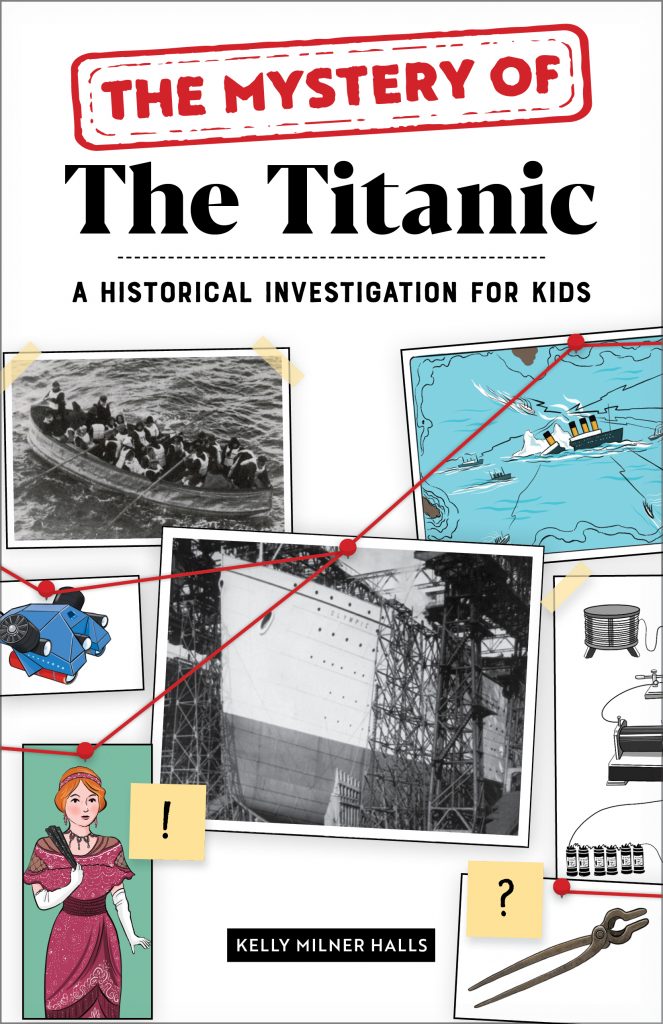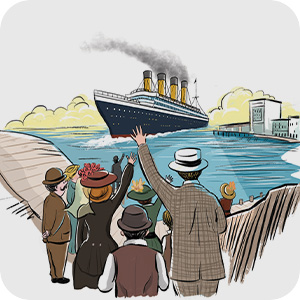
GUEST BLOGGER KELLY MILNER HALLS
Want to prove STEM matters? Study the R.M.S. Titanic.
Kids love the Titanic, but they focus on the iceberg and lives lost. That’s natural, but with a little nudge, they will question WHY the Titanic sank, and STEM will help answer that question.
Construction STEM on the Titanic
Titanic and her sister ships Olympic and Britannic were created by the White Star Line to compete with their competitor the Cunard Line’s twins, Lusitania and Mauritania. They were faster than anything White Star could create, so they went big and luxurious.
STEM—science, technology, engineering and math, made that possible. About 14,000 skilled Irish craftmen built the Olympic and the Titanic, side-by-side. Somehow, they shaped more than 2,000 giant steel plates—each 30 feet long and six feet wide—into a ship’s skin, the hull.
How did they join the metal plates? Three million red-hot rivets, some made of steel, some made of alloy, a mixture of steel and iron. The rivets added 1,500 tons to the weight of the Titanic. That’s a lot of weight, but consider this.
Titanic’s final weight was 24,000 tons–as much as 5,000 male Asian elephants. Wonder if it will float, sure, but first ask yourself–how did they move 24,000 tons from dryland to the River Lagen? Answer, 22 tons of soap and oil helped Titanic slip safely into the river, where she was watertight and stayed afloat. STEM made that possible.
STEM powers the Titanic
Huge furnaces the size of a two-car garage burned coal. Coal boiled water. Water became steam and that steam moved all three Titanic’s propellers and carried her to her tragic destiny—a spiral trip to the bottom of the North Atlantic Ocean.
Sad? It is, but how did it happen? What went wrong? What sent an “unsinkable” ship to her doom, taking hundreds of people with it? STEM offers powerful evidence.
Gathering evidence
Speed
White Star couldn’t beat Cunard’s ships, but they wanted to come close. So Titanic’s Captain Edward Jones pushed the ship to move at full speed. Did that help create a disaster?
Titanic had guards standing watch from the ship’s crow’s nest, high above the deck. They scoured the horizon for dangers, but the binocular cabinet was locked and the key was in a seaman’s pocket—a seaman that did not sail with the Titanic. No key, no binocular vision. Did that doom the Titanic?
When the watchmen finally did see the iceberg—a jagged chunk of ice that probably weighed a million tons, and measured 400 feet long by 1,700 feet tall—they tried to turn the ship to avoid hitting it. The nose was spared impact, but the side of the hull was ripped open, when it slammed against the obstacle.
Rivets
Now remember those rivets? The expensive steel rivets protected the bow of the ship—the nose. The cheaper alloy rivets closed the steel sheets on the hull. If they’d used steel ship-wide, would the Titanic have survived? If they had not turned, but rather hit the iceberg head on, would those rivets have held?
These questions are rooted in STEM.
Lifejackets and lifeboats
So was the loss of life on board the Titanic. A total of 2,233 people boarded the Titanic for its maiden voyage on April 10, 1912, thinking the ship was unsinkable. Four days later, Captain Smith ordered lifejackets passed out and lifeboats filled and hoisted into the ocean. Why wasn’t that enough?
Only sixteen lifeboats were required by law. Titanic had twenty. Seats were available for 1178 human beings—just over half of the souls on board. And while 1178 people could have been on the lifeboats, only 705 claimed seats.
The lifejackets were top notch. So why didn’t people floating in the water survive? STEM answers that question, too. The frosty waters of the North Atlantic had plunged to 28 degrees Fahrenheit on the night of April 14, 1902. Within 15 minutes in the icy water, hypothermia set in and claimed hundreds of lives.
Still more people were trapped inside the Titanic when the ship broke in two pieces and spiraled to the bottom of the sea.
S. O. S.
The Titanic radio operators sent out dozens of S.O.S. calls, begging for help. But most ships turned their wireless radios off after midnight. The closest ship, the Californian didn’t receive the calls for help until morning. The one nearby ship that did hear, the Carpathian was four hours away.
As the sun came up, the Carpathian rescued 705 people from Titanic’s lifeboats. Another ship carried a few hundred frozen bodies home to their families. But hundreds more were forever lost to the Atlantic.
Titanic experiments
Using those core facts, you can prepare a series of STEM experiments.
Strongest vs. weakest
- Gather several different types of materials available at hand: aluminum cans, steel nails, other metals, plastic milk carton caps, shells from the beach, staples, etc.
- Make a hypothesis. Which material is likelty to be the strongest fastener? The weakest?
- Wearing safety goggles, pound each of the materials with a hammer. Watch fingers!
- Which materials are strongest when hit by a hammer?
Brrr, it’s cold!
How much cold can the average student tolerate? Ask studeents to stand in a tub of lukewarm water, lukewarm water with a little ice, and lukewarm water with a lot of ice? Have students write down the length of time they tolerated the water in each tub and their feet felt.
Then, ask students to extrabolate to how it migh have felt in the icy North Atlantic.
Safety checks
How important is a check list when you attempt any task? How could the key have made it to the binocular cabinet?
And how important are safety regulations? Ninety-nine times out of 100, you won’t need 60 lifeboats on an ocean liner. But what happens when disaster strikes? Is the possibility of danger enough to consider adding more lifeboats to a ship? How do more lifeboats affect the weight of the ship and its buoyancy?
What could the White Star Line have done differently to ensure the safety of its passengers?
Nearly every aspect of the Titanic story lends itself to STEM realizations. And the dramatic nature of the true story gives each element of STEM added emotional value. So use that passionate interest. You just might help today’s young reader prevent the dangers of tomorrow.
Kelly Milner Halls has written carefully researched nonfiction for young readers for the past 30 years. With more than 60 books and 1,500 nonfiction magazine articles, she has achieved a trustworthy measure of success. But inspiring kids is her continuing aspiration. For more about Halls, visit www.wondersofweird.com.











Leave a Reply
Your email is safe with me.